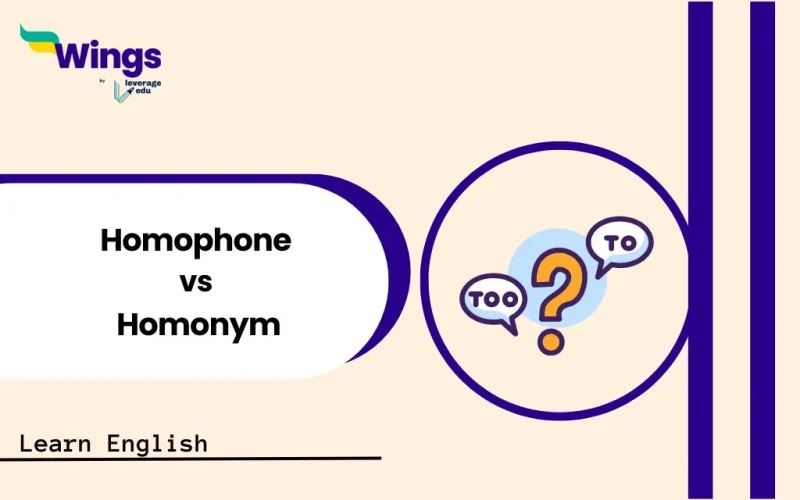Do words like “bat” (the animal) and “bat” (the baseball equipment) confuse you? Or do you sometimes mix up “to,” “too,” and “two”? You’re not alone! Many people struggle to differentiate between homophones and homonyms. While both terms involve words with similar sounds or spellings, they are not the same. In this blog post, we’ll break down the key differences between homophones and homonyms, providing clear examples to help you master these tricky word types.
This Blog Includes:
Defining Homophones
Let’s start with homophones. Homophones are words that sound the same but have different spellings and meanings. The emphasis here is on the identical sound.
Key characteristics of homophones:
- Same Sound: They are pronounced exactly alike.
- Different Spelling and Meaning: They have distinct spellings and unrelated meanings.
Examples of homophones:
- to, too, two:
- “I’m going to the store.”
- “I want to come too.”
- “I have two apples.”
- there, their, they’re:
- “Put the book over there.”
- “They love their dog.”
- “They’re going to the beach.”
- hear, here:
- “Can you hear the music?”
- “Come over here.”
Defining Homonym
Now, let’s look at homonyms. Homonyms are words that are spelled and pronounced the same but have different meanings. The focus here is on identical spelling and pronunciation.
Key characteristics of homonyms:
- Same Spelling and Pronunciation: They look and sound exactly the same.
- Different Meanings: They have unrelated meanings.
Examples of homonyms:
- bat:
- “The bat flew out of the cave.” (animal)
- “He swung the bat at the ball.” (baseball equipment)
- bank:
- “I deposited money at the bank.” (financial institution)
- “We sat on the river bank.” (edge of a river)
- fair:
- “The county held a large fair.” (event)
- “She has a fair complexion.” (light coloured)
Homophone vs Homonym: Key Differences
Let us now look at some of the key differences between homophones and homonyms, highlighting their definitions, examples, spelling, pronunciation, and their relationship to each other.
| Aspect | Homophones | Homonyms |
| Definition | Words that sound the same but have different meanings may be spelt differently. | Words that sound the same but have different meanings may be spelled differently. |
| Examples | – Pair (a couple) / Pear (a fruit) – Sea (large body of saltwater) / See (to perceive with the eyes) | – Bark (sound of a dog) / Bark (outer layer of a tree) – Bow (to bend forward) / Bow (a weapon) |
| Spelling | Different spellings for different meanings. | Same spelling for all meanings. |
| Pronunciation | Same pronunciation for all words. | Same pronunciation for all meanings. |
| Subcategories | A specific type of homonym focused on sound. | Can include both homophones and homographs. |
Homophone vs Homonym Examples
The table below mentions the list of examples of homophones along with their meaning and sentence examples.
| Homophone | Meaning | Example Sentence |
| Allowed | Given Permission | You are not allowed to smoke until you are 16. |
| Aloud | Spoken so that it can be heard | She spoke her thoughts aloud. |
| Bear | A large mammal | A bear is a large furry animal. |
| Bored | Feeling uninterested | To be bored is to have lost interest in something. |
| Board | A flat, thin, rectangular piece | A board is a flat piece of wood. |
| Break | To separate into pieces. | If you break something, you damage it. |
| Brake | To stop a vehicle | When you brake, the car slows down. |
| Flower | A blooming plant | A daffodil is a beautiful flower. |
| Flour | Powder made from ground grains | You need some flour to make the cake. |
| Here | In this place | Please come over here. |
| Hear | To perceive sound | Can you hear that noise? |
| Heal | To recover from injury | His leg will heal in a few weeks. |
| Heel | The back part of the foot | Your heel is at the back of your foot. |
| New | Recently made or acquired | I bought a brand new car. |
| Knew | Past tense of know | I knew the answer to the question. |
| One | The number 1 | There was only one piece of cake left. |
| Won | Past tense of win | She won the race last week. |
| Peace | A state of tranquillity | He marched for world peace. |
| Piece | A portion of something | I want a piece of that cake. |
Let us now look at the following list of homonyms with meanings.
| Homonym | Meaning 1 | Meaning 2 |
| Ad | Advertisement | Add (combine) |
| Advice | Guidance | Advise (recommend) |
| Altar | Table in church | Table in church |
| Band | A group | Banned (prohibited) |
| Bark | Sound of a dog | Bark (outer layer of a tree) |
| Bat | Animal | Bat (equipment for hitting ball) |
| Cell | Compartment | Sell (vend) |
| Cereal | Breakfast food | Serial (sequential) |
| Close | Opposite of open | Clothes (clothing) |
| Clip | Fastener | Clip (cut) |
| Complement | Enhance; go together | Compliment (praise) |
| Cool | Moderately cold | Cool (stylish) |
| Date | Calendar day | Date (romantic encounter) |
Explore similar blogs on Learn English below:
FAQs
Homophones are words that sound the same but have different meanings and spellings.
Homonyms are words that sound the same and have the same spelling but have different meanings.
The key difference is spelling. Homophones have different spellings, while homonyms have the same spelling.
Yes. Since homonyms sound the same, they are by definition also homophones. However because they also have the same spelling, they are further classified as a homonym.
Common examples of homophones are:
“to,” “too,” and “two”
“there,” “their,” and “they’re”
“hear” and “here”
“right” and “write”
Yes. Homographs are words that are spelt the same but have different pronunciations and meanings (e.g., “lead” as in metal and “lead” as in to guide). Homographs are a subset of homonyms.
We hope this blog on “Homophone vs Homonym vs Homograph” helped you improve your English skills. You can also follow the Learn English page of Leverage Edu for more exciting and informative blogs related to English grammar and the English language
 One app for all your study abroad needs
One app for all your study abroad needs















 60,000+ students trusted us with their dreams. Take the first step today!
60,000+ students trusted us with their dreams. Take the first step today!

